The Security System Tester Market is estimated to be valued at USD 1.8 billion in 2025 and is projected to reach USD 4.3 billion by 2035, registering a compound annual growth rate (CAGR) of 9.1% over the forecast period.
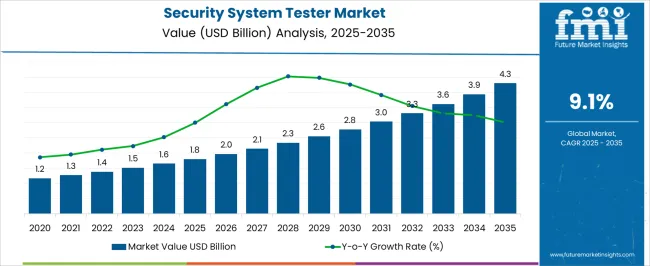
| Metric | Value |
|---|---|
| Security System Tester Market Estimated Value in (2025 E) | USD 1.8 billion |
| Security System Tester Market Forecast Value in (2035 F) | USD 4.3 billion |
| Forecast CAGR (2025 to 2035) | 9.1% |
The Security System Tester market is experiencing steady growth driven by the increasing adoption of robust cybersecurity measures across enterprises, government agencies, and critical infrastructure. The current market scenario is shaped by the need for proactive testing and validation of security systems to prevent breaches, ensure compliance, and maintain operational continuity.
Increasing reliance on digital systems and networked applications has elevated the importance of thorough security testing, which is further amplified by the growth of remote work and cloud-based deployments. The market is also being influenced by rising regulatory requirements and standards in cybersecurity, prompting organizations to invest in advanced testing solutions.
Future opportunities are expected to be driven by the adoption of intelligent testing frameworks that integrate automation, artificial intelligence, and real-time vulnerability analysis As organizations seek to strengthen their security posture while reducing risk and operational costs, the Security System Tester market is projected to witness continued expansion, underpinned by demand for scalable, reliable, and comprehensive testing solutions.
The security system tester market is segmented by application type, application service, tools, end user, and geographic regions. By application type, security system tester market is divided into Static Application, Dynamic Application, Interactive Application, and Mobile Application. In terms of application service, security system tester market is classified into Desktop Application, Mobile Application, Web Application, and Cloud Application. Based on tools, security system tester market is segmented into Automated Tools, Code Review Tools, Web Testing Tools, and Penetration Tools. By end user, security system tester market is segmented into BSFI, Government And Public Utilities, Healthcare, IT And Telecom Industry, and Retail. Regionally, the security system tester industry is classified into North America, Latin America, Western Europe, Eastern Europe, Balkan & Baltic Countries, Russia & Belarus, Central Asia, East Asia, South Asia & Pacific, and the Middle East & Africa.
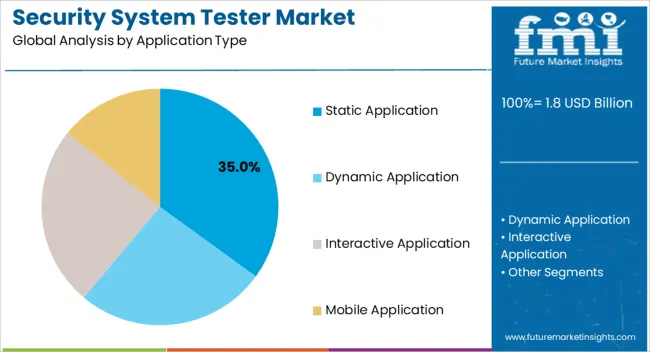
The Static Application segment is projected to hold 35.0% of the Security System Tester market revenue share in 2025, making it one of the leading application types. This dominance is being attributed to the increasing reliance on static testing methods to identify vulnerabilities in source code before deployment. Static analysis is favored because it allows early detection of security flaws, which reduces remediation costs and enhances overall software reliability.
The growth of this segment is further supported by the rising adoption of secure coding practices and the integration of static testing into continuous integration and delivery pipelines. Organizations are increasingly prioritizing early vulnerability identification to comply with regulatory requirements and avoid post-deployment breaches.
Additionally, static testing provides organizations with repeatable, systematic assessments, which improve the consistency and coverage of security audits As software systems continue to grow in complexity, the adoption of static application testing is expected to remain strong, reinforcing the segment’s leading position in the market.
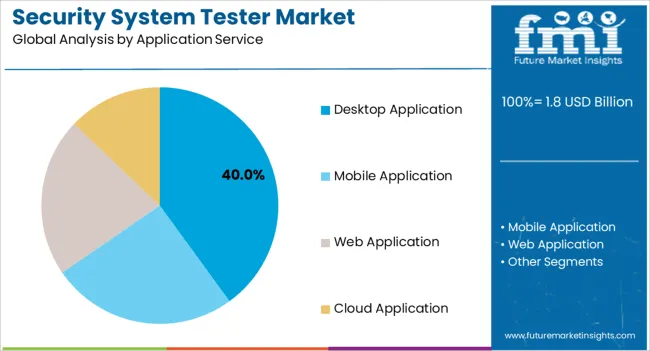
The Desktop Application segment is expected to capture 40.0% of the Security System Tester market revenue in 2025, making it the largest application service segment. This leadership is being driven by the widespread use of desktop-based enterprise applications in sectors such as finance, healthcare, and government, where data sensitivity and system reliability are critical.
The growth of this segment has been accelerated by the need to validate security controls in standalone environments, where local applications often handle confidential information. Desktop application testing ensures that vulnerabilities are identified before software reaches end users, preventing potential breaches and maintaining trust in organizational systems.
The segment benefits from the integration of automated security testing frameworks that streamline vulnerability detection, reporting, and remediation As organizations continue to rely on desktop applications for mission-critical operations, the demand for reliable and comprehensive testing solutions is expected to drive sustained growth in this segment, making it a central focus area for market expansion.
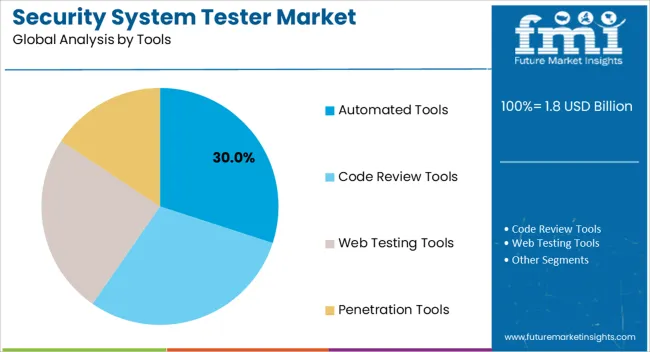
The Automated Tools segment is projected to account for 30.0% of the Security System Tester market revenue in 2025, reflecting the growing adoption of automation in security testing. This growth is being driven by the need for faster, more accurate, and repeatable testing processes that can scale across complex software environments.
Automated tools allow organizations to conduct extensive vulnerability scans, simulate attack scenarios, and generate actionable insights without manual intervention, thereby reducing operational overhead and human error. The segment has benefited from advancements in AI and machine learning, which have enhanced the precision and predictive capabilities of automated testing solutions.
Increased integration of automated tools into DevOps pipelines has also accelerated adoption, enabling continuous testing and faster release cycles With the rising emphasis on proactive cybersecurity and efficient risk management, the Automated Tools segment is expected to experience sustained growth, positioning it as a vital component of modern security system testing strategies.
There is an increase in the number of internet user as well as the rising dependency of an individual’s daily life on the internet. The penetration of the internet, as well as computer technologies in various enterprises as well as government agencies, have risen the concern about the security of the data provided and shared on the internet.
The assurance of the consumer about the safety of their data over the internet is one of major rising concern. The increase in the number of cybercrime and threatening applications have risen need and demand for Security System Tester.
The security system tester is used to check the ability of a system to detect and remove the vulnerability and security weaknesses from the system. Security system Tester takes a check on the security assessment of a computer system for any potential threats present on the system which can cause a loss in the information. Thus the demand for Security system Tester is expected to increase in the near future.
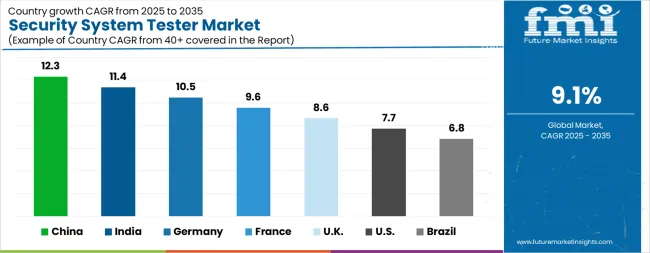
| Country | CAGR |
|---|---|
| China | 12.3% |
| India | 11.4% |
| Germany | 10.5% |
| France | 9.6% |
| UK | 8.6% |
| USA | 7.7% |
| Brazil | 6.8% |
The Security System Tester Market is expected to register a CAGR of 9.1% during the forecast period, exhibiting varied country level momentum. China leads with the highest CAGR of 12.3%, followed by India at 11.4%. Developed markets such as Germany, France, and the UK continue to expand steadily, while the USA is likely to grow at consistent rates. Brazil posts the lowest CAGR at 6.8%, yet still underscores a broadly positive trajectory for the global Security System Tester Market. In 2024, Germany held a dominant revenue in the Western Europe market and is expected to grow with a CAGR of 10.5%. The USA Security System Tester Market is estimated to be valued at USD 613.3 million in 2025 and is anticipated to reach a valuation of USD 1.3 billion by 2035. Sales are projected to rise at a CAGR of 7.7% over the forecast period between 2025 and 2035. While Japan and South Korea markets are estimated to be valued at USD 81.0 million and USD 51.9 million respectively in 2025.
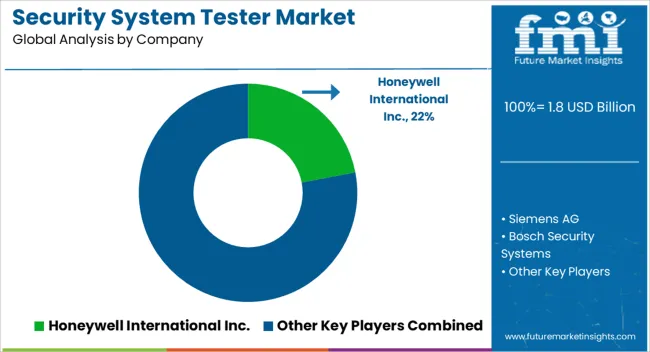
| Item | Value |
|---|---|
| Quantitative Units | USD 1.8 Billion |
| Application Type | Static Application, Dynamic Application, Interactive Application, and Mobile Application |
| Application Service | Desktop Application, Mobile Application, Web Application, and Cloud Application |
| Tools | Automated Tools, Code Review Tools, Web Testing Tools, and Penetration Tools |
| End User | BSFI, Government And Public Utilities, Healthcare, IT And Telecom Industry, and Retail |
| Regions Covered | North America, Europe, Asia-Pacific, Latin America, Middle East & Africa |
| Country Covered | United States, Canada, Germany, France, United Kingdom, China, Japan, India, Brazil, South Africa |
| Key Companies Profiled | Honeywell International Inc., Siemens AG, Bosch Security Systems, Johnson Controls International plc, Schneider Electric SE, United Technologies Corporation, ABB Ltd., and Emerson Electric Co |
The global security system tester market is estimated to be valued at USD 1.8 billion in 2025.
The market size for the security system tester market is projected to reach USD 4.3 billion by 2035.
The security system tester market is expected to grow at a 9.1% CAGR between 2025 and 2035.
The key product types in security system tester market are static application, dynamic application, interactive application and mobile application.
In terms of application service, desktop application segment to command 40.0% share in the security system tester market in 2025.






Our Research Products

The "Full Research Suite" delivers actionable market intel, deep dives on markets or technologies, so clients act faster, cut risk, and unlock growth.

The Leaderboard benchmarks and ranks top vendors, classifying them as Established Leaders, Leading Challengers, or Disruptors & Challengers.

Locates where complements amplify value and substitutes erode it, forecasting net impact by horizon

We deliver granular, decision-grade intel: market sizing, 5-year forecasts, pricing, adoption, usage, revenue, and operational KPIs—plus competitor tracking, regulation, and value chains—across 60 countries broadly.

Spot the shifts before they hit your P&L. We track inflection points, adoption curves, pricing moves, and ecosystem plays to show where demand is heading, why it is changing, and what to do next across high-growth markets and disruptive tech

Real-time reads of user behavior. We track shifting priorities, perceptions of today’s and next-gen services, and provider experience, then pace how fast tech moves from trial to adoption, blending buyer, consumer, and channel inputs with social signals (#WhySwitch, #UX).

Partner with our analyst team to build a custom report designed around your business priorities. From analysing market trends to assessing competitors or crafting bespoke datasets, we tailor insights to your needs.
Supplier Intelligence
Discovery & Profiling
Capacity & Footprint
Performance & Risk
Compliance & Governance
Commercial Readiness
Who Supplies Whom
Scorecards & Shortlists
Playbooks & Docs
Category Intelligence
Definition & Scope
Demand & Use Cases
Cost Drivers
Market Structure
Supply Chain Map
Trade & Policy
Operating Norms
Deliverables
Buyer Intelligence
Account Basics
Spend & Scope
Procurement Model
Vendor Requirements
Terms & Policies
Entry Strategy
Pain Points & Triggers
Outputs
Pricing Analysis
Benchmarks
Trends
Should-Cost
Indexation
Landed Cost
Commercial Terms
Deliverables
Brand Analysis
Positioning & Value Prop
Share & Presence
Customer Evidence
Go-to-Market
Digital & Reputation
Compliance & Trust
KPIs & Gaps
Outputs
Full Research Suite comprises of:
Market outlook & trends analysis
Interviews & case studies
Strategic recommendations
Vendor profiles & capabilities analysis
5-year forecasts
8 regions and 60+ country-level data splits
Market segment data splits
12 months of continuous data updates
DELIVERED AS:
PDF EXCEL ONLINE
Car Security System Market Trends – Size, Demand & Forecast 2025–2035
Industrial Security System Market Forecast Outlook 2025 to 2035
Transportation and Security System Market Size and Share Forecast Outlook 2025 to 2035
Security Tape Market Size and Share Forecast Outlook 2025 to 2035
Security Alarm Communicator Market Size and Share Forecast Outlook 2025 to 2035
Security and Vulnerability Management Market Forecast and Outlook 2025 to 2035
Security Holograms Market Size and Share Forecast Outlook 2025 to 2035
Security Paper Market Size and Share Forecast Outlook 2025 to 2035
Security Advisory Services Market Size and Share Forecast Outlook 2025 to 2035
Security Room Control Market Size and Share Forecast Outlook 2025 to 2035
Security Cameras (IR Illuminator) Market Size and Share Forecast Outlook 2025 to 2035
Security Operation Centre as a Service Market Size and Share Forecast Outlook 2025 to 2035
Security Robots Market Size and Share Forecast Outlook 2025 to 2035
Security Service Edge Market Size and Share Forecast Outlook 2025 to 2035
System-On-Package Market Size and Share Forecast Outlook 2025 to 2035
Security and Surveillance Equipment Market Size and Share Forecast Outlook 2025 to 2035
Security Orchestration Automation and Response (SOAR) Market Size and Share Forecast Outlook 2025 to 2035
Security Bags Market Size and Share Forecast Outlook 2025 to 2035
Security Screening Market Analysis - Size, Share, and Forecast 2025 to 2035
Systems Administration Management Tools Market Size and Share Forecast Outlook 2025 to 2035

Thank you!
You will receive an email from our Business Development Manager. Please be sure to check your SPAM/JUNK folder too.
Chat With
MaRIA